Abstract
A simplified approach was used to determine if “Less is More” is still a trend in comics’ Peking opera characters. There were 225 website volunteers who took part in the study. Via a questionnaire survey and analysis, this study explored the feasibility of “simplification” in comedy. The results indicate that the proposed “simplifying” approach can be applied to the creation of dramatic characters, but the scale of simplification must be adjusted flexibly to suit different subjects. For audiences, there is not much recognition and sympathy for the works that are simplified in the extreme and the current symbolization. The simplification used in this study is merely the first step in testing the usefulness of simplification as an approach. It is used as a means of understanding the cognition of the audience to accept the simple features of Peking opera characters. In subsequent studies, the proposed “simplified” approach is necessary to adapt and improve with a view to practical application. It also requires an in-depth analysis of the cognitive differences of the different participants according to the cognitive and communication theories of artistic creation.
1. Introduction
The principle of “Less is more, More is confusing” can be set as far back as the philosophical values put forth in The Book of Changes [] (p. 440). This expression refers to the idea that today, there are too many opportunities to choose from. Face with these temptations and opportunities, people can easily get lost themselves and then fall into confusion without knowing what to choose. The same situation exists in the creative field; “less is more” has a worldwide reputation and impact which is still noticeable today [].
Whereas “less is more” is best applied when speaking of good design, these few words of wisdom can be applied just about anything in life. Numerous studies have shown that the study of “less is more” is effective for assessing an understanding of human behavior. According to Norton et al. [], the effect of “less is more” can be accounted for within the framework of ambiguity and familiarity. Evidence shows that less information leads to greater sympathy, and more information leads to less sympathy. Therefore, the aim of this research is designed to explore how the concept of “less is more” affects comic creation. The results give some explanations for the concept of “less is more”. Finally, this study will also discuss how to select the appropriate creative method.
In the field of art and design creation, “doing subtraction” has traditionally been a difficult but interesting issue [,,]. From prehistory to the present, and from east to west, many philosophers, artists, and designers have promoted different opinions with how to “make subtraction when creating art and design”. This research combines the above philosophy with the aesthetic principles of Chinese painting to propose an approach for comic creation and evaluation as a way to simplify the creation of characters in traditional opera. From here, it is possible to understand whether the viewer of Peking opera approves of this mode of creation and the content and details in which they are interested.
The article is inspired by one of the views of modern design, “less is more”, and explores the feasibility of a “simplification” idea through comical creation. The concept of “less is more” is without a doubt successful when applied to modern design, but whether it can be successfully applied to other artistic creations requires further discussion. The purpose of this research has been summed up in the following two points:
- This study is aimed at exploring how comic creation can be used to simplify the character of opera characters, and to study whether the audiences can understand the creator’s motivation and ideas. Meanwhile, the factors affecting the evaluation of works of art will also be studied.
- As a series of studies, the simplification used in this study is just the first step in testing the usefulness of simplification as a creative method. This also shows that the aim of this study is to simplify the application of the philosophy of “less is more, more is confused” in the creation of Peking opera, which deserves further discussion and review.
2. Literature Review
2.1. Visual Features for Icon Design
Simplification is a key element of the concept of “less is more”. It can be shown from many designs that the designer only knows to do subtraction in the design process and ignores the subtraction of design elements in order to enhance the meaning of the product. For example, with an iconic interface design, the designer will encounter an issue in selecting an appropriate design style for the icon. For icons go from highly abstract symbols to representative symbols. Lin identified three distinctive features of an object that can be distributed among developers and users. The three distinctive traits of an object, taking the nautilus as an example, are form, function, and image [,]. The three features are further described as follows:
- Shape Feature. A shape characteristic acts as an example of a general class of objects. A form function is not an exact copy of a form of an object, but rather a reflection of the relevant qualities of an object.
- Function Feature. A function is used to get designers to look for structural principles in the design to create their own pictures. The result of the design derived from the functionality is involved in a particular action as necessary as the conclusion of a geometry theorem.
- Image Features. A picture function attempts to present a concept to a spectator who is outside the real picture. The graphic form represents the perceptive content of an object or concept that it represents. Image functionality is not the intent of this design style to show the form of an object. On the other hand, the image function is designed to transmit the image of an object—an image at a higher level of abstraction than the symbol itself.
2.2. Levels of Stylization
Meyer et al. [] defines “Levels of Stylization” as the representation of useful and essential visual elements of an object in terms of its identification. Additionally, he exemplified the five levels of stylization by an “object” apple perceptual content of an object or concept. It then concludes that others are styled by shape feature, image feature, or their combinations. Using the nautilus as an example, stylization levels based on visual characteristics are illustrated in Figure 1. In each of these visual characteristics, any “object” can be styled from an “actual thing” to a “useful icon”: From shape, picture, or functionality of representation icon, either abstract or arbitrary [,].
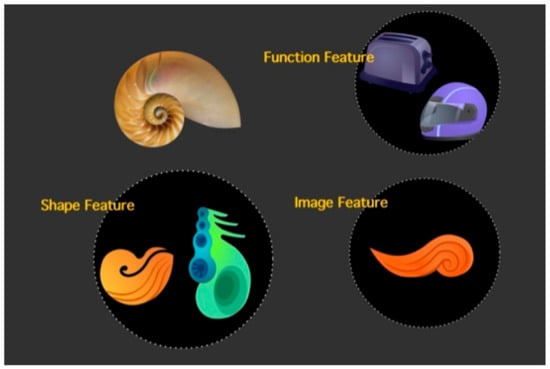
Figure 1.
Levels of stylization for nautilus.
When “less is more” comes to graphic design, simplicity plays a key role in guiding the viewer’s attention and helping them understand a design. In this multimedia era, information and distraction overflow, our minds and eyes crave simplicity. Simple is better than something advanced or complicated. Following the “less is more” rule is critical when designing because the basis of graphic design is communication. How is the relationship between the designer and the audience potentially altered in communications? Before beginning any communication activity, designers want to start with the following question: (1) How can designers create less to deliver more? (2) Can designers take away (even more) to make more impact? If you complicate what you are communicating, then your design will never be recognized. The fewer elements there are in the mix, the better the chances that both of these goals will be shared. The design takes the form of imagining and planning the idea that there is more than the visual look of something. While design is at the same time an art and a science, the art of design is in how designers combine visuals and verbal to create an innovative idea that will connect with their audience [,].
However, there is no common visual language shared between designers and users. It not always easy to categorize icons as abstract or representative since an “object” can be stylized on a continuous scale of abstraction. Graphists are more interested in style of an object in relation to a symbol than in its classification as representative or abstract. At its core, any object can be “stylized” or “abstract”.
Actually, there has been very rigorous research work conducted on the specific topic of simplification. Wang and Hsu [,] argued that in design areas, graphic design is often a means of communication aimed at achieving mutual understanding. However, graphic design is often considered an artistic behavior that is difficult to analyze rationally. They carried out a detailed analysis and discussion in two papers. In the paper what they completed in 2010, they continued their previous research and discussed the relationship between shape features and degrees of graphic simplification [].
2.3. Communication Matrix
Victor Papanek (1923–1998) [] pointed out: “Design is the conscious and intuitive effort for imposing significant control”. It just means that the design should be meaningful, which means that if we design a product in a way that is easy for users to use. It can help them reach their goals, and they will be pleased and happy []. However, whether the audience can understand the intention of the designer or creator is more worthy of discussion. Although most viewers have not received education or training in the field of art, this does not prevent them from appreciating artistic work. For example, consider a famous painting, Mona Lisa by Leonardo da Vinci (1452–1519): some people are very fascinated and they have to take a look even if they may be unable to see clearly from a distance. Therefore, because viewers come from different backgrounds and everyone’s life experience and aesthetics are different, adopting appropriate modeling semantics in design and comic creation and clearly conveying the artist’s intentions and ideas to the viewer is a task that is not easy to complete. Indeed, just as for the designer or artist, the process of ensuring the audiences’ appreciation and interpretation of the work is also a design process, and vice versa.
Generally, in the creation process, a simplified way of thinking should be adopted, and simplification is the central point. For people, these elements that are taken away by the artist cannot have any impact on their interest and preference. Therefore, for the creators there is a need from the perspective of consumers and audiences during the simplified creative process.
In the era of social media, the relationship between the artist and the audience is increasingly close. For artworks be effective in communicating, they need to be meaningful, understandable, memorable, etc. In order to evaluate artwork, it is necessary to identify the cognitive factors that affect them. The importance of communication studies is demonstrated on a regular basis in many artworks’ evaluation studies. Despite the recognized importance of social interaction between the artist and the audience, there is no systematic approach to explore it. Lin investigated the factors affecting the valuation of works of art. These factors are then analyzed and examined in order to establish a communication matrix for understanding the artist’s and the audience’s perceptions. These factors can then serve as a basis for the evaluation of artwork during the creative phase []. This study proposed an approach combining cognition and communication theory that incorporated the three dimensions of assessing works of art, as shown in Table 1.

Table 1.
The communication matrix for evaluating artwork.
Unlike existing assessment tools, this communication matrix is a multidimensional assessment tool that puts the artist and the artist-iterated values of the citizen at the heart of the matrix. Its first dimension makes it possible to identify the fundamental values involved in any work of art, including performance, procedures, and products. Its second dimension makes it easier to identify the associated theory which may have to be taken into account in the evaluation of the results and impact. This includes the theory of communication, the mental model and the treatment of information. The third dimension is flexibility, because the matrix can be adapted to the needs and priorities of the various contexts of the artist, the spectator and the work. It makes it possible to identify appropriate the quality and impact measures and indicators.
2.4. Simplicity of Chinese Paintings
Leaving space is a very important method used by the Chinese painter to create attractive work. The blank space will fulfill whatever interaction is desired. This research analyzes a Chinese classical aesthetic of form, spirit, and image, and demonstrates that the creative concept of leaving space is a kind of simplicity. One of the most important parts of a picture is the space for the imagination of an audience. What can you remove from your conception that will encourage people to become interested? People enter into an experiment when parts of it are deliberately indefinite. A simple space transforms an art object into a personal imagination of the unique relationship between the artist and audience sharing. The artist can leave a space as a message, draw a picture, or forego the hint all together.
Therefore, “Form” stands for the figure of a person, the physical body and the characteristics of a character. Additionally, “Spirit” means the mind of a person, that is, the central value of life and the inherent mind of a person. “Image” is a long-standing issue in traditional Chinese aesthetics. It conveys the unique principles of traditional Chinese aesthetics and its aesthetic charm, highlighting the artistic conception from the standpoint of its functionality and the aesthetic tastes of the artists.
Another principle known as “The Six Principles of Chinese Painting” was established by Xie He (see Appendix B). The six principles for evaluating a painting are redefined [] (p. 353). This study is based upon four simplified principles. Its fundamental concept is that in the process of simplification, one must maintain the temperament and connotation of the role.
It should be pointed out that the scope of Chinese painting is very broad, including a lot of principles. Only a small part of the principles selected for this study are used in the simplified creation of comics. After studying the related research [,,,], this study concluded that simplicity in Chinese painting is not only subtracting the obvious elements, but also adding something meaningful, and four skills were identified to simplify in the creation process, namely “Transfer Features to Form”, “Transform Features to Spirit”, “Reflect Spirit to Semantics”, and “Ignore Form to Essence”, as shown in Figure 2.
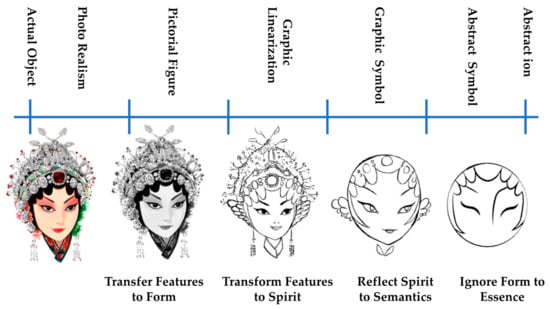
Figure 2.
The process of simplification and comparison with the levels of stylization (Source: this study).
In summary, based on the six principles of Chinese painting by Xie He (see Appendix B), and the idea of “less is more”, this study proposed the following four guidelines for the creation and evaluation of this study. They are described in the following manner:
- Transfer Features to Form. The central idea is objective representation and direct expression, underscoring the basis of the form and respecting the shape of the object. Such a way of manifesting is to obtain a lively resemblance to the “form” of the characters.
- Transform Features to Spirit. In general, the form is the bearer of the spirit. Without the form, the spirit will not be transmitted at all. Form and spirit are related to preponderance and subordination. Painters must manifest the intrinsic essence of a figure and follow the mind through the shape of the painting.
- Reflect Spirit to Semantics. As Xie [] said: “Spirit Resonance, or the vitality, and seems to translate to the nervous energy transmitted from the artist into the work. If a painting is without ‘spirit resonance’, there is no need to look further”. Likewise, where encounters of comic creation are implicit elements of opera, it will add some semantic effects. The form and spirit of the opera will form symbolic images and underline the implicit features of opera culture.
- Ignore Form to Essence. Traditional Chinese philosophy is a poetic philosophy and an artistic philosophy which follows “implication beyond lines”, “image beyond pictures”, and “intention beyond tastes”. In traditional Chinese aesthetics and philosophy, they often attach great importance to the concepts and ignore forms. In this last principle, the focus is on how to outline the character with the simple lines, while retaining the rich dramatic connotation and the spirit behind the character. In short, the form is the simplest and the content is the most abundant.
3. Method
3.1. Research Framework
Traditional opera and modern comics, which have very strong characteristics, are two different kinds of art. There is rigorousness denoted in the sensuous performance of traditional opera, and the creation process of contemporary comics has a perceptual connotation. Along with the history, these two kinds of art present their individual artistic characteristics in different ways. The artwork can express the customary cultural connotation and modern aesthetic style that is connected with the core spirit of Chinese aesthetics. Therefore, this study refers to the six Chinese classical aesthetic principles to analyze the connotation of traditional opera and build the creative concept of comics. Based on the theory of cognition and communication, first, this study analyzed the features of dramatic characters and the semantic meaning of performing actions. Then, innovative figures of Peking opera comics were created to evaluate the feasibility methods and strategies for the creation of dramatic comics.
The study of communication involves three levels of problems: technical, semantic, and effective. The technological level demands that the spectator attractions are recognized by their senses. The semantic level requires that the spectator accurately realizes the sense of the message through its realization. The level of efficiency refers to the ways in which the spectator is brought to take moral reflection through his/her knowledge [,,,,]. Starting with the image formation of the opera and using comics to express the shape and spirit of the characters, Lin [] proposed the four steps of the creative process: (1) set a scenario, (2) tell a story, (3) write a script, and (4) create a comic—which extends the comic creation process of opera elements into a unique creative model called “Ignore Form to Essence”. Analysis of the practice of comic creation to achieve the purpose of “Reflect Spirit to Semantics”, in order to establish a research framework for the comic creation of simplified opera, is shown in Figure 3.
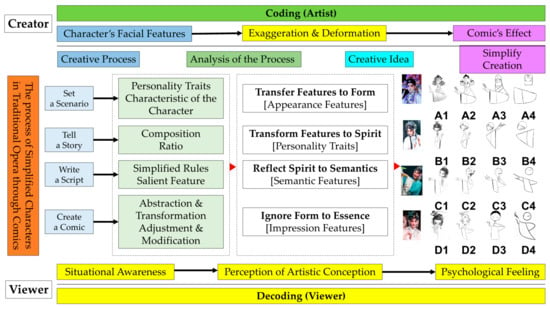
Figure 3.
Research framework (Source: this study).
3.2. Procedure
The process was divided into three stages, as illustrated in Figure 4. The first step focuses on literature, including the creation of cartoons, the characteristics of traditional opera, and the theory of communication. Based on the concepts and theories above, a creative theory consisting of the following four characteristics is built: (1) “Transfer Features to Form”, (2) “Transform Features to Spirit”, (3) “Reflect Spirit to Semantics”, and (4) “Ignore Form to Essence”.
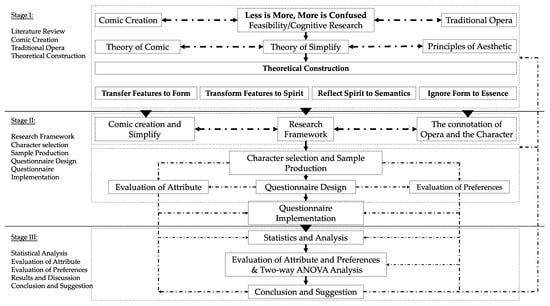
Figure 4.
Three stages of research (Source: this study).
The main content of the second stage consists of using the comic as a creative method to simplify the creation of characters in Peking opera. More precisely, it is divided into the research framework, selection of personal, sample creation, questionnaire content design, and implementation. As the proverb says: “Follow the rules and make your own way”. There are likewise certain methods and procedures for comics to simplify the creation of opera. This article explores how comics simplify the language form of an opera based on the principles of aesthetics and regularity of artistic creation. During the creative process, the author captures the characters’ characteristics in the original image and performs targeted “transformation” and “simplification”.
This study looks for the elements that best reflect their quality from the expressions, dynamics, clothing, and accessories of the characters in the original image. Then, by imagining and constructing specific stories and situations, the author progressively creates simplified work in order to achieve a harmonious and balanced state, while retaining emotions and cultural connotations. Additionally, the third stage focuses on statistical analysis, including the analysis of subjective preferences and attribute evaluation. Finally, we make inferences based on the findings of the data analysis, summarize the conclusions, and make recommendations.
3.3. Samples
After a historical evolution, four basic types of characters were formed in the opera, called Sheng, Dan, Jing, and Chou (four main role types in Peking opera). Among them, Dan’s characters were very distinctive. The Dan refers to any female role in Peking opera, and it was originally divided into five subtypes [,,]. This type of character usually has a smart posture and a charming figure. During the performance, it can show the character’s soft and delicate, light and flexible characteristics, which are very suitable for comics. A Kun Opera master Pai Yun-sheng has summed up the image of “Dan” as 3 features: beautiful, lively, and veracious. In this study, the role of “Dan” in the opera was chosen as the sample, and the simplified portion of comics is adopted to make the comic closer to life and more intimate. According to the four principles of “Transfer Features to Form”, “Transform Features to Spirit”, “Reflect Spirit to Semantics”, and “Ignore Form to Essence”, 4 photos from the characters in the opera were simplified and created. Figure 5 shows all 16 images after simplifying.
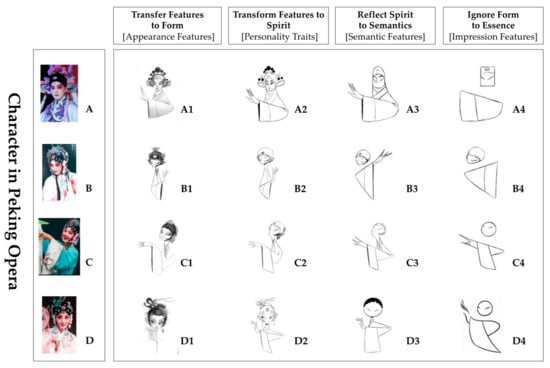
Figure 5.
The samples and the four simplification steps (Source: this study).
3.4. Questionnaire
This article is to explore how comic creation can be used to simplify the character of opera characters and to study whether the viewer can understand the creator’s motivation and ideas and assess the feasibility of such simplified creation [,,]. This study proposes a two-stage evaluation method to design the questionnaire content. The first stage is the evaluation of attribute. Participants need to evaluate the images of the 4 comic works in different simplified processes one by one according to the four evaluation attributes; the size of each image remains the same. A 5-point Likert scale was utilized to score the responses from 1 to 5. The second stage is the overall evaluation of preferences. For more information on the questionnaire, please consult Appendix A.
3.5. Participants
A questionnaire has been completed online. Within 48 h, a total of 225 valid questionnaires was compiled. Table 2 shows the distribution of participants according to gender, age, education, and background. Related research shows that it is generally recommended that the number of questionnaires should be 3–5 or 5–10 times the number of the most subscale questions in the test [,,]. Therefore, the number of valid questionnaires retrieved for this study meets the above requirements, and subsequent statistics and analysis can be conducted.

Table 2.
Distribution of participants.
4. Results and Discussion
4.1. Evaluation of Overall
Based on the participants’ responses, the average and standard deviation of the 16 samples of the 4 comics and the ranking of the score on each question is shown in Table 3. These data can be used as a reference when further comparing the differences between different cases.

Table 3.
The mean and SD of the participant’ responses to the 4 evaluation attributes.
By analyzing the number of votes on the nine questions in the second and third parts of the questionnaire (Table 4), the following characteristics can be found. Images of the different simplified processes of “Comic-D” won the highest recognition of all issues. However, the number of votes for the first place is not very high, most of them being concentrated in the 10~30% interval, and the votes of other samples are also relatively close, indicating that there is no great consensus among the participants. In addition, most of the images acknowledged by the participants came from the first two stages of the simplified process. Participants selected the most simplified sample (e.g., D4) only for a few issues.

Table 4.
Voting status of 9 questions in evaluation of preferences I and II.
However, images of different simplification stages of comic-D most recognized by the participants did not score very high on the attribute evaluation and were mostly located in the middle and late stages. The individual assessment of the four images of the simplification process may not capture the overall simplification process, resulting in a low recognition of the individual images.
4.2. Discussion
The view and idea of simplified creation from the author were “Less is more, more is confused”. It can be observed in the findings that the favorite images of the audience are not the most simplified. The participants’ favorite images are from different simplification stages of comic-D, such as D4 (Figure 6). There was no requirement in the questionnaire for the participants to answer the simplified process of which groups of comics work they liked most. Therefore, taking comic-D as typical, the results of comic-D in “Evaluation of Attribute” and “Evaluation of Preferences I and II” are used for further discussion.
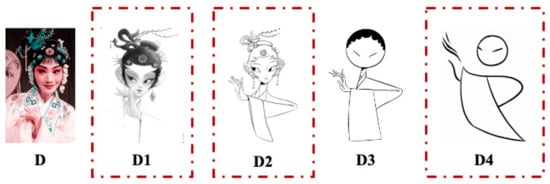
Figure 6.
The most recognized sample in evaluation of preferences (Source: this study).
Table 5 shows the sample of the highest recognition of the nine questions about the evaluation of preferences I and II. D4 is the most simplified and tends to be symbolized. It discards almost all the details and focused on the dynamics of the characters in the original work. Therefore, D4 has obtained the greatest recognition from the participants in terms of “Creative expression”, “Form”, and “Symbol”. D1 and D2 are also most favored on other issues. For example, D4, A4, B4, and C4 are the most simplified images that tend to be symbolized. These samples can only be recognized by the participants on issues related to “shape”, and the score and votes obtained in other evaluations are in the middle and lower positions. From the perspective of simplification, D2 received the highest recognition. It can be understood that it is not so simple, and that it is the most appropriate to be symbolized. However, the most simplified sample D4 has the most recognition in creative expression, which shows that the idea of “simplification” has a certain degree of creativity, but it needs further scrutiny on the degree of simplification.

Table 5.
The sample that received the highest recognition in evaluation of preferences I and II.
The two-way ANOVA analysis also includes the interaction between the different simplification stages and evaluation attributes. Results of participant effects testing are presented in Table 6. Factor I (Attribute) and Factor II (Simplified) reached a level of significance. It shows that different attributes and simplified processes will affect the evaluation of the participants. Since the interaction between “Factor I and II” also achieved a significant level (F = 101.936, p < 0.001), the simple main effect analysis was required (Table 7).

Table 6.
Tests of between-participants effects.

Table 7.
Summary of simple main effect.
Factor I and II were controlled by “Simple main effect”. The results show that both of them were clear differences. Specific differences may be found using the one-way ANOVA analysis described below.
- From different evaluation attributes, we can find: (1) In “Attribute 1”, there is not any difference between simplifying 3 and 4. The results of multiple comparisons between other groups were II-2 > II-1, II-3 > II-1, II-4 > II-1, II-2 > II-3, and II-2 > II-4. (2) In “Attribute 2”, there are differences in simplify 1 and 3, simplify 2 and 3, and simplify 2 and 4. The results of multiple comparisons between other groups were as follows: II-1 > II-3, II-2 > II-3, and II-2 > II-4. (3) In “Attribute 3”, there is not any difference between simplify 3 and 4. The results of multiple comparisons between other groups were II-1 > II-2, II-1 > II-3, II-1 > II-4, II-3 > II-2, and II-4 > II-2. (4) In “Attribute 4”, there is not any difference between simplify 3 and 4. The results of multiple comparisons between other groups were II-1 > II-2, II-1 > II-3, II-1 > II-4, II-3 > II-2, and II-4 > II-2.
- From different simplification stages, we can find: (1) In “Stage 1”, there is no difference between attribute 3 and 4. The results of multiple comparisons between other groups were I-2 > I-1, I-3 > I-1, I-4 > I-1, I-3 > I-2, and I-4 > I-2. (2) In “Stage 2”, there is no difference except between attribute 3 and 4. The results of multiple comparisons between other groups were I-1 > I-2, I-1 > I-3, I-1 > I-4, I-2 > I-3, and I-2 > I-4. (3) In “Stage 3”, the differences are only between attribute 1 and 3. The results of multiple comparisons between other groups are as follows: I-4 > I-3. (4) In “Stage 4”, there are differences in attributes 1 and 3 and attributes 2 and 3. The results of multiple comparisons between other groups were as follows: I-1 > I-3 and I-2 > I-3.
- It can be seen from Figure 7 and Figure 8 that (1) Between the images of the first two stages of simplification, except for the similar evaluation on the second attribute, there are big differences in the other three attributes. Nevertheless, the two images have a certain point of continuity, no matter how they are expressed or simplified, which is why such a large difference in cognition is worthy of further study. (2) The images of the last two stages of simplification have very similar evaluations on all attributes, and there is not much fluctuation. In terms of details, the score of stage 4’s image is comparatively high. The above results can explained: In terms of the “simplification” itself, the perception that participants have of the simplified image is relatively stable. However, they do not like images that are too simplified (close to symbols). This is in agreement with the results in Table 5.
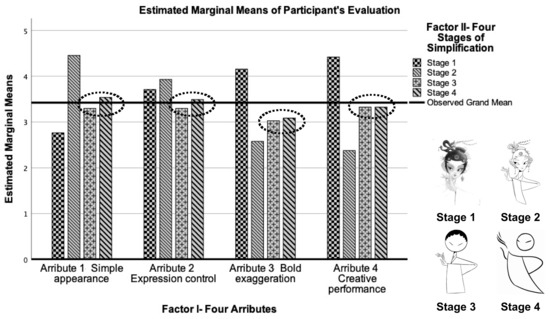 Figure 7. Profile plots of interaction between factor I (attribute) and factor II (simplified).
Figure 7. Profile plots of interaction between factor I (attribute) and factor II (simplified).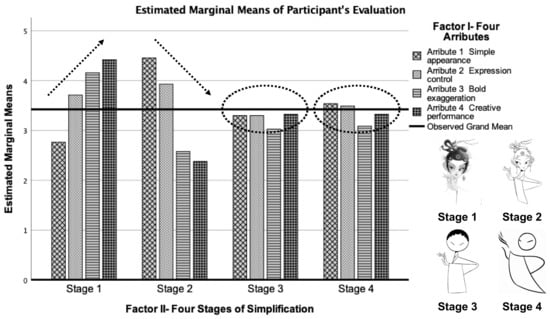 Figure 8. Profile plots of interaction between factor II (simplified) and factor I (attribute).
Figure 8. Profile plots of interaction between factor II (simplified) and factor I (attribute).
5. Conclusions and Suggestions
This study is guided by the philosophical idea of “Less is more, more is confused” of the ancient Chinese, and draws lessons from the creative thinking of the traditional Chinese aesthetics. It used the four concepts: “Transfer Features to Form”, “Transform Features to Spirit”, “Reflect Spirit to Semantics”, and “Ignore Form to Essence” to construct a creative mode. We use comic expressions to simplify the characters in traditional opera to explore the feasibility and applicability of the author’s construction model through a questionnaire survey and analysis to understand whether the audience agrees with this simplified creative mode. This creative idea and mode may serve as a reference for other creators. Comments from the audience indicated that gaps in the creative channel and communication process were further mitigated. The conclusions of the study are as follows:
- The audience did not like images that were simplified to the extreme, which tended to be symbolic. They preferred samples which retain the main features of the original and underwent artistic treatment with a certain simplification.
- For the creators of this article, simplified creative ideas are feasible, but it is necessary to choose suitable and appropriate simplified processing methods according to different objects in order to let viewers understand the creator’s intentions.
- In this study, because of differences in gender, age, education, and background of the viewers, there will also be separate cognitive differences between them. This can be explored in future research. The audience of traditional opera is relatively certain and may be mainly middle-aged and older people who like traditional culture. For creators and researchers, attracting interest from other groups has become a very interesting and significant issue. Simplified imaginative thinking in the form of comics can play a role and can also be an inspiration to other researchers.
Furthermore, this study still contains the following limitations and gaps, which will be completed and enhanced in the follow-up research. The related problems and solutions are as follows:
- The samples selected in this study have adopted the same simplified model and creative style. Participants may experience visual fatigue when answering outstanding questions. In future research, we may expand the size of the comparison group. Additionally, the author plans to add more characters from the Peking Opera to the research sample. This can reduce the cognitive limitations of a single sample type to better capture participant preferences and trends through comparison.
- The evaluation criteria for this article are jointly influenced by Chinese philosophy, Chinese painting theory, and Mies’s design thought. However, most respondents always use subjective intuition as the basis for their judgement. Therefore, it is not easy to explain the connotation of the artwork from a “scientific” perspective. Simplification is not the only way to “Less is more, More is confused” because simplification is a trade-off process. Future comic creators will need to consider how to reduce the details of the creation process, but still enable the audience to “get” the whole appearance of people. This also shows that the aim of this study is to simplify the application of the philosophy of “Less is more, More is confused” in the creation of opera, which deserves further discussion and review.
In short, the body language of opera characters has undergone hundreds of years of evolution, which contains a high level of refinement of beauty. In the creation of comics, in addition to the vivid depiction of the characters, the overall effect of the image and the aesthetic experience of the viewer must also be considered. It should let the audience feel the content of the external comic image, and at the same time, also taste the formal aesthetic feeling of the comic forms. For creators, it is necessary to choose an appropriate form to express opera elements so that the audience can comprehend the creative intentions of the creator. The simplification used in this study is merely the first step in testing the usefulness of simplification as an approach. It is used as a means of understanding the cognition of the audience to accept the simple features for Peking opera characters. Further studies are needed. In subsequent studies, the proposed “simplified” approach is necessary to adapt and improve with a view to practical application. It also requires an in-depth analysis of the cognitive differences of the different participants according to the cognitive and communication theories of artistic creation (Figure 9).
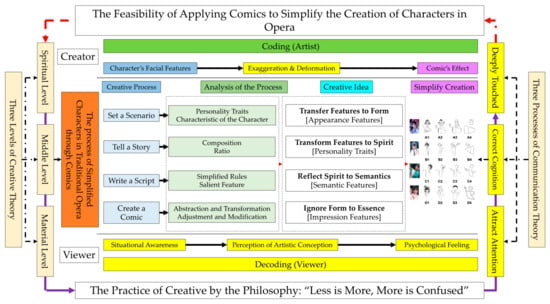
Figure 9.
The framework of future research (Source: this study).
Author Contributions
Data curation, Writhing—review and editing, R.-T.L.; Resources, J.W.; Writing—original draft, Y.S. All authors have read and agreed to the published version of the manuscript.
Funding
This research was funded by the Philosophy & Social Sciences Planning Project, Anhui Province, China, No. AHSKQ2020D145.
Institutional Review Board Statement
Not applicable.
Informed Consent Statement
Informed consent was obtained from all subjects involved in the study.
Data Availability Statement
The data that support the findings of this study are openly available in the repository Open Science Framework at http://doi.org/10.17605/OSF.IO/FUV8S (accessed on 18 October 2021).
Conflicts of Interest
The authors declare no conflict of interest.
Appendix A

Table A1.
The questionnaire.
Table A1.
The questionnaire.
| Part 1: Evaluation of Attribute Based on the following four attributes; please subjectively evaluate the strength of the attributes corresponding to each work in the four stages of each comic work in the simplified process. Here are four groups of comics in total, and each group of comic has four images in different simplified processes. Every image needs to be answered to the same questions regarding the four attributes. | |
| Sample and the four stages of simplification | Evaluation attributes and scoring standard |
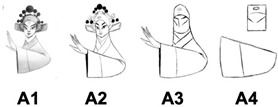 | 1. Simple Appearance Very unfit ☐1 ☐2 ☐3 ☐4 ☐5 Very fit 2. Expression Control Very unfit ☐1 ☐2 ☐3 ☐4 ☐5 Very fit 3. Bold Exaggeration Very unfit ☐1 ☐2 ☐3 ☐4 ☐5 Very fit 4. Creative Performance Very unfit ☐1 ☐2 ☐3 ☐4 ☐5 Very fit |
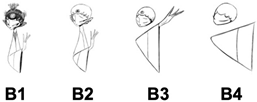 | 1. Simple Appearance Very unfit ☐1 ☐2 ☐3 ☐4 ☐5 Very fit 2. Expression Control Very unfit ☐1 ☐2 ☐3 ☐4 ☐5 Very fit 3. Bold Exaggeration Very unfit ☐1 ☐2 ☐3 ☐4 ☐5 Very fit 4. Creative Performance Very unfit ☐1 ☐2 ☐3 ☐4 ☐5 Very fit |
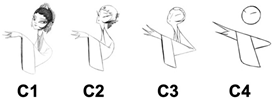 | 1. Simple Appearance Very unfit ☐1 ☐2 ☐3 ☐4 ☐5 Very fit 2. Expression Control Very unfit ☐1 ☐2 ☐3 ☐4 ☐5 Very fit 3. Bold Exaggeration Very unfit ☐1 ☐2 ☐3 ☐4 ☐5 Very fit 4. Creative Performance Very unfit ☐1 ☐2 ☐3 ☐4 ☐5 Very fit |
 | 1. Simple Appearance Very unfit ☐1 ☐2 ☐3 ☐4 ☐5 Very fit 2. Expression Control Very unfit ☐1 ☐2 ☐3 ☐4 ☐5 Very fit 3. Bold Exaggeration Very unfit ☐1 ☐2 ☐3 ☐4 ☐5 Very fit 4. Creative Performance Very unfit ☐1 ☐2 ☐3 ☐4 ☐5 Very fit |
| Part 2 and 3: Evaluation of Preferences I and II Based on the following nine questions, select the image you think is most suitable. | |
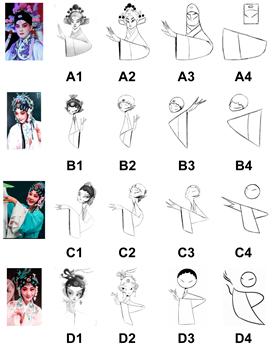 | Evaluation of preferences I 1. Which image is simplified to a most appropriate degree do you think? ☐A1 ☐A2 ☐A3 ☐A4 ☐B1 ☐B2 ☐B3 ☐B4 ☐C1 ☐C2 ☐C3 ☐C4 ☐D1 ☐D2 ☐D3 ☐D4 2. Which image can best express the creativity? ☐A1 ☐A2 ☐A3 ☐A4 ☐B1 ☐B2 ☐B3 ☐B4 ☐C1 ☐C2 ☐C3 ☐C4 ☐D1 ☐D2 ☐D3 ☐D4 3. Which image shows the richest elements of a cartoon? ☐A1 ☐A2 ☐A3 ☐A4 ☐B1 ☐B2 ☐B3 ☐B4 ☐C1 ☐C2 ☐C3 ☐C4 ☐D1 ☐D2 ☐D3 ☐D4 4. Which image has the best overall expression? ☐A1 ☐A2 ☐A3 ☐A4 ☐B1 ☐B2 ☐B3 ☐B4 ☐C1 ☐C2 ☐C3 ☐C4 ☐D1 ☐D2 ☐D3 ☐D4 5. Which image you like best in terms of expression approach? ☐A1 ☐A2 ☐A3 ☐A4 ☐B1 ☐B2 ☐B3 ☐B4 ☐C1 ☐C2 ☐C3 ☐C4 ☐D1 ☐D2 ☐D3 ☐D4 Evaluation of preferences II 6. Which image do you think stresses the resemblance of “form” on the basis of form? ☐A1 ☐A2 ☐A3 ☐A4 ☐B1 ☐B2 ☐B3 ☐B4 ☐C1 ☐C2 ☐C3 ☐C4 ☐D1 ☐D2 ☐D3 ☐D4 7. Which image conveys the spirit with the use of skillful techniques and emotional experience? ☐A1 ☐A2 ☐A3 ☐A4 ☐B1 ☐B2 ☐B3 ☐B4 ☐C1 ☐C2 ☐C3 ☐C4 ☐D1 ☐D2 ☐D3 ☐D4 8. Which image highlights the cultural characteristics by forming visual images of symbols through form and spirit? ☐A1 ☐A2 ☐A3 ☐A4 ☐B1 ☐B2 ☐B3 ☐B4 ☐C1 ☐C2 ☐C3 ☐C4 ☐D1 ☐D2 ☐D3 ☐D4 9. Which image reflects the conception and neglects the form and becomes an objective symbolic image? ☐A1 ☐A2 ☐A3 ☐A4 ☐B1 ☐B2 ☐B3 ☐B4 ☐C1 ☐C2 ☐C3 ☐C4 ☐D1 ☐D2 ☐D3 ☐D4 |
Appendix B

Table A2.
The content of six principles of Chinese painting created by Xie He.
Table A2.
The content of six principles of Chinese painting created by Xie He.
| 1. “Spirit Resonance”, or vitality, and seems to translate to the nervous energy transmitted from the artist into the work. The overall energy of a work of art. Xie said that without Spirit Resonance, there was no need to look further. |
| 2. “Bone Method”, or the way of using the brush. This refers not only to texture and brush stroke, but to the close link between handwriting and personality. In his day, the art of calligraphy was inseparable from painting. |
| 3. “Correspondence to the Object”, or the depicting of form, which would include shape and line. |
| 4. “Suitability to Type”, or the application of color, including layers, value, and tone. |
| 5. “Division and Planning”, or placing and arrangement, corresponding to composition, space, and depth. |
| 6. “Transmission by Copying”, or the copying of models, not only from life but also the works of antiquity. |
Source: []. Xie He (FL. 6th century), a Chinese art historian, art critic, painter, and writer of the Liu Song and Southern Qi dynasties.
References
- Hohne, K. The Essential I Ching: 64 Degrees of Nature’s Wisdom; Way of Tao Books: Carnelian Bay, CA, USA, 2015. [Google Scholar]
- Chernev, A. When More is Less and Less is More: The Role of Ideal Point Availability and Assortment in Consumer Choice. J. Consum. Res. 2003, 30, 170–183. [Google Scholar] [CrossRef]
- Norton, M.I.; Frost, J.H.; Ariely, D. Less is More: The Lure of Ambiguity, or Why Familiarity Breeds Contempt. J. Pers. Soc. Psychol. 2007, 92, 97–105. [Google Scholar] [CrossRef] [PubMed] [Green Version]
- Ayu, P. Designing Caricature in Teaching Writing for EFL Learners. Res. Engl. Educ. J. 2016, 1, 1–9. [Google Scholar]
- Browne, J.E. Darwin in Caricature: A Study in the Popularisation and Dissemination of Evolution. Proc. Am. Philos. Soc. 2001, 145, 496–509. [Google Scholar]
- Medley, S. Discerning Pictures: How We Look at and Understand Images in Comics. Stud. Comics 2010, 1, 53–70. [Google Scholar] [CrossRef]
- Lin, R. A Study of Visual Features for Icon Design. Des. Stud. 1994, 15, 185–197. [Google Scholar] [CrossRef]
- Lin, R. A Study of Nature Form for Basic Design Instruction. J. Technol. 1987, 2, 17–24. [Google Scholar]
- Meyer, R.P.; Laveson, J.I.; Puls, D. An Experience-Judgement Approach to Tactical Flight Training. Proc. Hum. Factors Soc. Annu. Meet. 1981, 25, 657–660. [Google Scholar] [CrossRef]
- Washburn, D.K. Structure and Cognition in Art; Cambridge University Press: Cambridge, MA, USA, 1983. [Google Scholar]
- Wang, R.W.; Hsu, C.C. Study of the Design Operation of Graphic Simplification. Des. J. 2007, 10, 54–75. [Google Scholar] [CrossRef]
- Wang, R.W.; Hsu, C.C. The Method of Graphic Abstraction in Visual Metaphor. Visible Lang. 2007, 41, 284–297. [Google Scholar]
- Hsu, C.C.; Wang, R.W. The Relationship Between Shape Features and Degrees of Graphic Simplification. J. Des. 2010, 15, 87–105. [Google Scholar]
- Papanek, V. Design for the Real World; Academy Chicago Publishers: Chicago, IL, USA, 1985. [Google Scholar]
- Importance of Communication in the Design Process. Available online: https://uxdesign.cc/importance-of-communication-in-the-design-process-b686b5885623 (accessed on 21 March 2021).
- Lin, R.; Qian, F.D.; Wu, J.; Fang, W.T.; Jin, Y.G. A Pilot Study of Communication Matrix for Evaluating Artworks. Cross-Cult. Des. 2017, 356–368. [Google Scholar] [CrossRef]
- China: A Cultural and Historical Dictionary; Dillon, M. (Ed.) Curzon Press: London, UK, 1998. [Google Scholar]
- Bai, Q.S. Image as Word: A Study of Rebus Play in Song Painting (960-1279). Metrop. Mus. J. 1999, 34, 57–72. [Google Scholar] [CrossRef]
- Murch, A. Words in Chinese Painting. In A companion to Chinese Art; Powers, M.J., Tsiang, K.R., Eds.; John Wiley & Sons: Hoboken, NJ, USA, 2015; pp. 457–474. [Google Scholar]
- Silbergeld, J. Chinese Concepts of Old Age and Their Role in Chinese Painting, Painting Theory, and Criticism. Art J. 1987, 46, 103–114. [Google Scholar] [CrossRef]
- Binyon, L. The Flight of the Dragon: An Essay on the Theory and Practice of Art in China and Japan, Based on Original Sources; John Murray: London, UK, 1911. [Google Scholar]
- Briessen, F.V. The Way of the Brush: Painting Techniques of China and Japan; Tuttle: Rutland, UK, 1962. [Google Scholar]
- Craig, R.T. Communication Theory as a Field. Commun. Theory 1999, 9, 119–161. [Google Scholar] [CrossRef]
- Fiske, J. Introduction to Communication Studies; Routledge: London, UK, 2010. [Google Scholar]
- Jakobson, R. Language in Literature; Harvard University Press: Cambridge, MA, USA, 1987. [Google Scholar]
- Lin, R. Transforming Taiwan Aboriginal Cultural Features into Modern Product Design: A Case Study of a Cross-cultural Product Design Model. Int. J. Des. 2007, 1, 45–53. [Google Scholar]
- Goldstein, J. Mei Lanfang and the Nationalization of Peking Opera, 1912-1930. East Asian Cult. Crit. 1999, 7, 377–420. [Google Scholar] [CrossRef]
- Halson, E. Peking Opera: A Short Guide; Oxford University Press: Oxford, UK, 1966. [Google Scholar]
- Peking Opera. Available online: https://en.wikipedia.org/wiki/Peking_opera#Performers_and_roles (accessed on 2 April 2021).
- Lin, C.L.; Chen, J.L.; Chen, S.J.; Lin, R. The Cognition of Turning Poetry into Painting. J. US-China Educ. Rev. B 2015, 5, 471–487. [Google Scholar] [CrossRef] [Green Version]
- Comrey, A.L. Factor-analytic Methods of Scale Development in Personality and Clinical Psychology. J. Consult. Clin. Psychol. 1988, 56, 754–761. [Google Scholar] [CrossRef] [PubMed]
- Tinsley, H.E.; Tinsley, D.J. Uses of Factor Analysis in Counseling Psychology Research. Couns. Psychol. 1987, 34, 414–424. [Google Scholar] [CrossRef]
- Wu, M.L.; Tu, J.T. SPSS & The Application and Analysis of Statistics; Wu-Nan Book Inc.: Taipei, Taiwan, 2011. [Google Scholar]
Publisher’s Note: MDPI stays neutral with regard to jurisdictional claims in published maps and institutional affiliations. |
© 2022 by the authors. Licensee MDPI, Basel, Switzerland. This article is an open access article distributed under the terms and conditions of the Creative Commons Attribution (CC BY) license (https://creativecommons.org/licenses/by/4.0/).